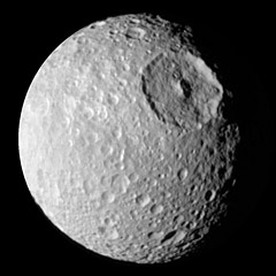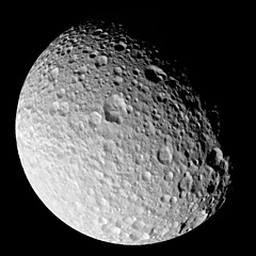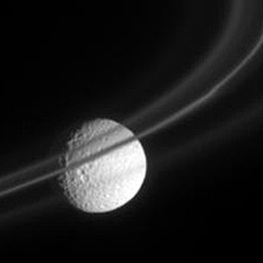Our Solar System
Mimas

Mimas is an inner moon of Saturn (the innermost of the major moons) and looks somewhat like a bull's eye if viewed from a certain angle. Mimas and another Saturn moon, Rhea, have been called "the most heavily cratered body in the Solar System." Mimas would probably have been more heavily cratered except, being closer to Saturn, Mimas was warmer (and consequently softer) for a longer time so early features have faded away. However, with so many impacts the youngest craters have tended to obliterate the older ones, and these moons are cratered about as much as they can get.
The Unlucky Titan

Mimas is the seventh of Saturn's known moons in order of orbit and is also the seventh largest. It is the 20th largest moon in the Solar System and is the thought to be the smallest to have its shape rounded by its own gravity. Mimas was discovered by the British astronomer, Sir William Herschel in 1789. Most of what we now know about Mimas was discovered during the two Voyager missions.
Features of Mimas

The low density of Mimas indicates that it is composed almost entirely of water ice, very much like Dione and Rhea. Mimas is also covered with small impact craters, but the cratering is not even. Most of the craters average about 25 miles (40 km) in diameter, but craters in the South Polar Region average only 12 miles (20 km). This suggests something may have covered up the larger craters. The fact that none of the other craters are as large as Herschel have led some astronomers to speculate that a previous impact may broken the moon into pieces, which then coalesced to reform the moon into what we see today. Mimas has no detectable atmosphere and no magnetic field.
Statistics for Mimas
Discovered by - William Herschel
Year of Discovery - 1789
Diameter - 246.6 miles (397 km)
Mean Distance from Saturn - 115,326 miles (185,520 km)
Rotational Period - 22.55 Hours
Orbital Period - 22.55 Hours
Orbital Eccentricity - 0.0202
Orbital Inclination - 1.5 degrees
Mean Surface Temperature - -328 F (-200 C)
Main Atmospheric Component - None
Apparent Magnitude - 12.9
Year of Discovery - 1789
Diameter - 246.6 miles (397 km)
Mean Distance from Saturn - 115,326 miles (185,520 km)
Rotational Period - 22.55 Hours
Orbital Period - 22.55 Hours
Orbital Eccentricity - 0.0202
Orbital Inclination - 1.5 degrees
Mean Surface Temperature - -328 F (-200 C)
Main Atmospheric Component - None
Apparent Magnitude - 12.9
